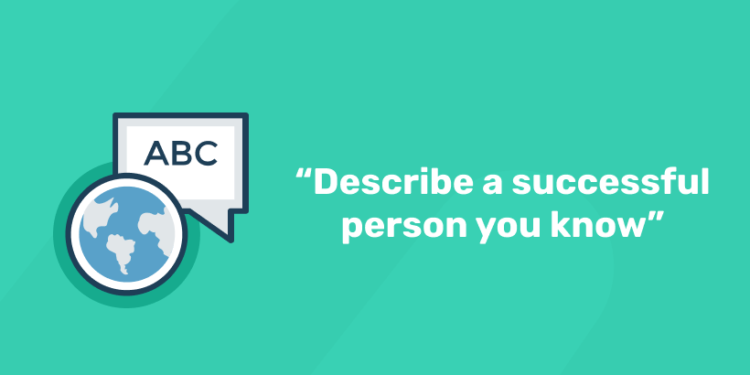Table of Contents
IELTS exams can have different questions with varying complexities in each aspect. One such simple, yet tricky cue card for IELTS Speaking Part 2, is to ‘describe a successful person you know.’ This blog helps you understand the cue and the requirements it has.
Introduction: Understanding the “Describe” Cue Card Questions
The “Describe” cue card questions are part of the Speaking module of an IELTS exam. It serves as a mechanism to assess the speaking capability of the candidate. A cue card will be provided along with some bullet points on which the candidate should be speaking.
A minute is given for preparing the answer, after which the candidate has to speak continuously for 1 to 2 minutes. The assessment criteria for Speaking are as follows:
Fluency: Ability to speak smoothly and logically while maintaining continuity.
Vocabulary: The range and precision of vocabulary with which meaning is expressed and conveyed.
Grammar: The range and accuracy of grammar used.
Pronunciation: The ability to produce comprehensible speech with accurate stress and emphasis on words.
How to Approach “Describe a Successful Person You Know”
1: Most university students ........................ on campus in their first year.
- Read the “Describe” cue card carefully and identify the key prompts or asks.
- Utilise the 1-minute to prepare and brainstorm ideas.
- Note down the key points in a bullet point format rather than full-fledged sentences.
- Think of a logical order to present your answer.
- Begin with an introductory sentence.
- Provide a brief summary before going into the details.
- Cover each prompt in detail and add extra information wherever possible.
Master the IELTS Exam with Online Coaching- Enroll Today!
Ace Your IELTS Exam with Confidence!
Unlock your potential with our expert-led IELTS preparation course. Achieve your dream score and open doors to global opportunities!
Start Your IELTS Journey Today!Structuring Your Answer: The Ideal Format for “Describe a successful person you know”
The process of tackling this particular “Describe” cue card requires you to break down the whole answer according to the prompt questions.
Your response should be satisfying the following requirements:
- Who is this person?
- How do you know him/her?
- What does he/she do?
- Explain why he/she is successful.
Here is a step-by-step approach towards structuring the answer:
1. Comprehending the ask
The focus should be on a successful person you know and why he/she is successful. The examiner will be looking for ways in which you are able to provide an explanation of events, a description of feelings, and a reflection of your experience.
2. Planning the response
Utilise the 1-minute prep time to plan the response in an effective manner. Promptly choose a relevant person who will be suited for describing. Make sure to select a person about whom you can talk at length.
3. Structuring the response
Structure the response into 3 parts:
i) Introduction: Briefly introduce the person
Example: One of my favourite actors and the most successful people I’ve ever known is Thalaiva Rajinikanth, a legendary South Indian superstar, and a cultural icon. He’s one of the highest-paid celebrities in India, but his childhood wasn’t as luxurious as it is now.
ii) Body: Cover all the requirements of the question and incorporate it into the answer
iii)Conclusion: Sum up all of the points and provide an overview of the overall experience with the person.
Example Answer: A Model Response for “Describe a successful person you know”
-
Who is this person?
“One of the most promising people I have known in my life is my cousin, Sunaina, who has built a successful business in the tech industry. She is currently the Chief Technology Officer (CTO) of a well-known software company, where she has played a key role in developing innovative solutions for businesses around the world.”
-
How do you know him/her?
“Sunaina and I had been best buddies since childhood. Despite a friendly rivalry between our families, we have never let it affect our relationship. Growing up, we helped each other in studies and extracurricular activities. She has always been curious, smart, determined and hard-working, the qualities that have helped to reach the place she had aimed for.”
-
What does she/he do?
After completing her engineering degree, she moved abroad for higher education and earned a master’s degree in Artificial Intelligence from a prestigious university. She stayed back in the country and worked for several multinational companies, where she gained vast experience and climbed the corporate ladder. With the knowledge and experience she gained there, she came back to her native land with an actionable plan for her own startup. Today, as the CTO, she leads a team of hundreds of engineers and is responsible for making strategic decisions that shape the future of her company.
-
Explain why he/she is successful
“Sunaina’s vision and work ethic are what genuinely distinguish her and made her successful. She has always been committed to lifelong learning, fast to adapt to new technology, and forward-thinking. Along with her technical proficiency, she possesses excellent leadership qualities that motivate others to give their best effort. Her success also stems from her ability to strike a balance between short-term obstacles and long-term objectives. In addition, she truly loves to innovate, which has led to her company creating ground breaking goods that have completely changed the way companies run.”
Tips for Practicing and Preparing for the ‘Describe’ Cue Cards
The preparation process for “Describe” cue cards require strategic practice to build confidence, fluency, and the ability to organize your thoughts effectively. Below are some tips that would help you prepare better:
1) Familiarize Yourself with Common Topics
Make a list of common topics and brainstorm ideas for each. Make use of online resources or cue card lists to find topics to practice.
2) Ace the structure
Make use of a logical structure which includes the introduction, topic, details, personal reflections, and conclusion.
3) Vocab-ulous!
Practice and play with descriptive adjectives, verbs, and idioms to make the answer engaging. Aim to keep the examiner hooked to your answer.
4) Practice=perfect
Choose a random cue card and practice speaking for 2 minutes. Record it and evaluate yourself in terms of fluency, grammar, and vocabulary. Try pairing with a friend or join an IELTS-speaking group online or offline.
5) Simple yet complex
Use linking words to join sentences instead of just stating them. Though this seems simple, without proper practice and expertise, it can backfire.
6) No pain, no gain
Explore unfamiliar topics, which will help in mastering improvisation. This is a good opportunity to identify weaknesses and work upon them.
Ace Your IELTS Exam with Confidence!
Unlock your potential with our expert-led IELTS preparation course. Achieve your dream score and open doors to global opportunities!
Start Your IELTS Journey Today!Conclusion
The preparation process can be a bit overwhelming, especially the IELTS Speaking “Describe” Cue Cards. However, with the right mindset and materials one can easily acquire the desired band.
A lot many online and offline platforms provide coaching and materials for the exam. Entri is one of the leading platforms in the IELTS market along with a record of successful candidates. Enroll in their IELTS coaching courses for effective support during your preparation.
Master the IELTS Exam with Online Coaching- Enroll Today!
Ace Your IELTS Exam with Confidence!
Unlock your potential with our expert-led IELTS preparation course. Achieve your dream score and open doors to global opportunities!
Start Your IELTS Journey Today!Frequently Asked Questions
What are some tips for performing better in the IELTS Speaking test?
Some good practices to improve your performance for your Speaking test are:
- Understand the task properly
- Use the preparation time wisely
- Do not by-heart your answers
- Speak clearly and fluently
- Check Vocabulary and Grammar
What is the duration of the IELTS cue card section?
The duration of your cue card section is 3-4 minutes. The first minute is the preparation time. You can use this to prepare and structure your answer well. Later, you will be given 2-3 minutes to speak. Speak confidently and make sure your speech is audible, clear, and concise.
How many hours is the IELTS speaking test?
The IELTS speaking test is only 11-14 minutes long. You have three parts in your IELTS Speaking test. The duration of each part is as follows:
- Part 1: Introduction and Interview (4-5 minutes)
- Part 2: Long turn or Cue Card (3-4 minutes)
- Part 3: Discussion (4-5 minutes)
What are some common mistakes in IELTS speaking?
Some of the common mistakes made during the IELTS Speaking test are:
- Poor pronunciation: Make sure you pronounce words clearly with proper pronunciation.
- Lack of vocabulary: Do not use the exact words. Instead of repeating the same term, replace it with synonyms to display your vocabulary.
- Taking too many pauses: Do not take too many pauses between your answers. This might look like you are stammering for words.
- Lack of Confidence: Answer confidently and calmly.
- Being inaudible: Make sure your answers are audible.
How is the Speaking Test graded?
The test is scored on four things:
- Fluency (how smoothly you speak)
- Vocabulary (the words you use)
- Grammar (how correctly you use language)
- Pronunciation (how well you say words)










